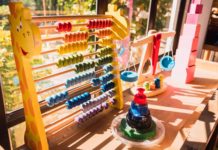
It's time to rethink the way you're teaching your kids the ABCs—and have more fun and reading success while you do! Reading lessons don't always have to happen hunched over a book. There are ways to learn the ABCs and other important reading foundations and building blocks all around us, if we know where to look for them.
To put my reading teacher hat on and get super serious for a second, it's important to remind you that when we rely on things like the traditional ABCs while teaching our kids to learn the alphabet, they're often replacing comprehension with memorization.
At Big City Readers, my children's education company, we have created activities to prevent that. Below are three fresh, engaging, and simple ways to teach your toddler the ABCs—no fancy equipment or even books required.
1. Use Alphabet Animals
One powerful way to ease little ones into alphabet exploration and take the pressure out of learning to write letters is to weave the practice into activities your kids already love to do like drawing. Add animals into the mix for even more fun.
All species, including butterflies and kittens, can become alphabet art projects. Yes, we can see, identify, and teach multiple letters in them, but you can also highlight even more basic and simple alphabet and letter lessons, such as the curves and dots of the letters.
Here's how this works: I set up two spots with paper and a crayon. I do not bring any attention to what I am doing and instead just narrate what I am drawing. I draw a circle and say, "Hm, what could this be? Oh, it's a circle, it could be a head, a letter O, part of a P. What other letters are inside this shape?"
I will model drawing something at the developmental age a child is at. For example most 2- to 3-year-olds can draw lines and circles so if they ask you to draw a cat, think about focussing on the lines and circles and going slow enough that they, if they choose, can draw it next to you.
When kids are 4 to 5 they can start drawing diagonal lines so the drawings could get a little more detailed.
Remember that with a little bit of creativity and attention to your child's approximated developmental level, you can expand this lesson to all types of animals, shapes, flowers, seascapes—you name it!
2. Play a Game of I Spy
You've heard of sneaking vegetables into your kid's snacks right? Well, this is how I sneak ABCs lessons into everyday activities: play Snack Time I Spy. What I love about this activity is how it can be easily modified to accommodate different comprehension levels and there are countless variations and twists on it you can add.
All this activity needs is a kitchen, fridge, or even a to-go lunch or snack on the road. You're going to use whatever you're eating to play I Spy games anchored in alphabet lessons. For instance: "I spy something that begins with the letter C;" "I spy something that ends with the letter E;" "I spy something that starts with the 'Ch' sound;" "I spy something that rhymes with 'bees.'" The possibilities are as endless as there are snacks and letter combinations.
This alphabet activity is a learning tool because it gets little mouths used to forming different sounds, identifying letters, and applying them to everyday items so they begin to make the connection between letters, words, and real-life objects.
3. Search for ABCs All Around
Too often when parents are teaching kids to read, they think it has to happen in a specific way—at a desk or in front of a book with a lesson of some kind. Quite the opposite! I created Big City Readers largely to help support parents in the first five years and show them that letters and words can be part of our everyday routines, and if we make an intentional plan to do so, we can turn outings to the coffee shop, grocery store, and even road trips into a lesson about our ABCs.
Beyond just noticing letters and words on things like signs, store windows, packages at the grocery store, and so forth, it's important to extract a lesson from them. Here are some examples:
You see a "Stop" sign: "What letters do we see here? Let's put the sounds together slow and fast." Once they get that far you can add: "This sign tells us to stop moving. These letters (sound them out again) are on a sign that is telling us to stop." You can then also ask: "Why is this sign here?"
At a coffee shop: "OK everyone, look for something that starts with the letter C." "Let's all look for a sign with the letter C, who can find it?" "Let's sound out this word that starts with an L on this sign."
You are at a grocery store: "Hey, look at this letter E. What does that sound like?" "What else do we see?" "OK, a G and another G! Let's sound it out: Eggs. So, this box is telling us there are eggs in here!"
The Bottom Line
There is one alphabet, but many ways that teach it that extends beyond our old, standard ABCs. These fun lessons combined with that classic learning tool can help ensure your kids aren't just saying the letters but are actually understanding the power behind them.
You can find Beth Gaskill online (@BigCityReaders) for more reading tips, tricks, and book suggestions.





